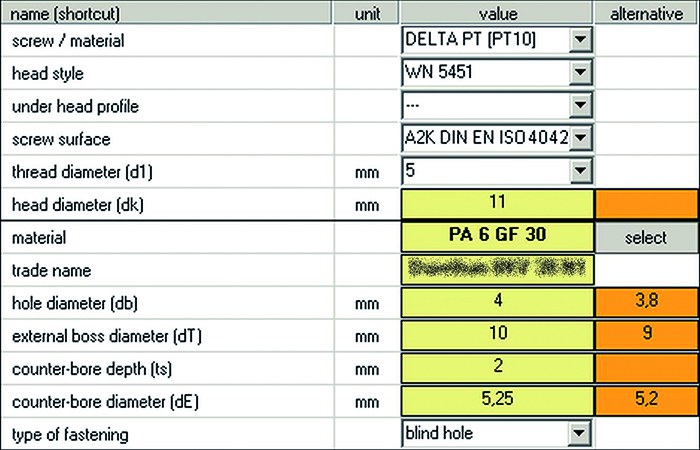
Global fastener specialist EJOT has two products which in combination make it much easier for designers and engineers to optimise the strength and speed of automated fastenings into thermoplastics.
EJOT’s DELTA PT® screw is a high-capacity, self-tapping fastener for strong and reliable direct fastening into thermoplastics and DELTA CALC prognosis software has been developed by EJOT to support designers at the pre-engineering modelling stage, by enabling clamp loads to be accurately calculated for thermoplastics applications using the DELTA PT® screw. Its early use produces significant cumulative cost savings.
The rationale for DELTA CALC was that existing similar software tools were geared to the requirements of international engineering standard VDI (Verein Deutscher Ingenieure) 2230, which primarily addresses screw joints in metals. Its guidance has little applicability to self-tapping joints in plastics.
In particular, VDI 2230 has no guidance about how the properties of thermoplastic materials affect the process of thread-forming.
EJOT’s R&D, based on data from many thousands of applications and test assemblies, has shown that reliable clamp load calculations are perfectly possible for direct fastening of DELTA PT® screws into thermoplastic material. From this R&D the DELTA CALC tool emerged to offer optimisation and time-and-cost-saving benefits to industrial designers.

The DELTA CALC® software tool is powerful enough to have multiple applications but its essential characteristics are:
Design of the boss hole
For dimensioning of the boss hole, the default DELTA CALC® calculation applies the design guidelines of the EJOT DELTA PT®. In practice, these often offer scope for variations, the effects of which can be simulated by DELTA CALC (see image II). Its internal database makes around 350 different thermoplastics available for calculation of the joint.
Clamp load design
Clamp load is the main quality criterion of a screw joint, and so is the primary focus of DELTA CALC®. By specifying the clamp load and the mating and clamping material, the screw dimension and tightening torque required for process reliability can be calculated. A reverse calculation - working from a specified tightening torque to the clamp load - is also possible with DELTA CALC®.

Optimum assembly parameters
DELTA CALC® is able to predict the potential for different failure modes, such as thread stripping or screw fracture, and the exact point of their occurrence - for example, thread stripping at or beyond clamp load. This feature makes it possible to optimise installation parameters to minimise failure risk and ensure process-reliable assembly.
Predicting long-term performance of a screw joint
Clamp loads created by tightening torque can decrease over time owing to the natural relaxation of thermoplastic materials. Changes in temperature can also have an effect. Rates of loss can be predicted with DELTA CALC and mitigated against.
Advantages of DELTA CALC
Use of EJOT’s DELTA CALC software to pre-calculate DELTA PT screw joints can significantly reduce component design, development and testing time. The ability to use data to optimise assembly also prevents over-dimensioning of screw joints.
Cumulatively, there are multiple cost savings in material, weight, error correction and development time. Even these cost savings can be calculated!
DELTA CALC also makes a unique contribution toward quality improvement.
Try DELTA CALC ‘lite’ for free right now
DELTA CALC is available to EJOT customers online.
Simply visit https://www.ejot.co.uk/industrial-service follow the ‘CAD & more’ link and either login or register.
This gives free access to a ‘lite’ online version of DELTA CALC. It is designed for maximum user friendliness so that it can be tried out immediately and independently.
For more complex applications that may be beyond the scope of the ‘lite’ version, simply contact EJOT and ask for advice and support.
Tel: 01977 687040
Fax: 01977 687041
Email: info@ejot.co.uk










Water Sector Talent Exodus Could Cripple The Sector
Well let´s do a little experiment. My last (10.4.25) half-yearly water/waste water bill from Severn Trent was £98.29. How much does not-for-profit Dŵr...